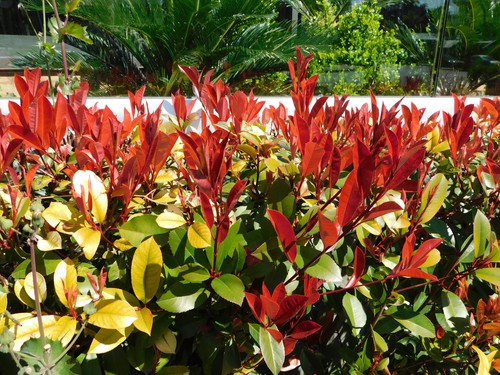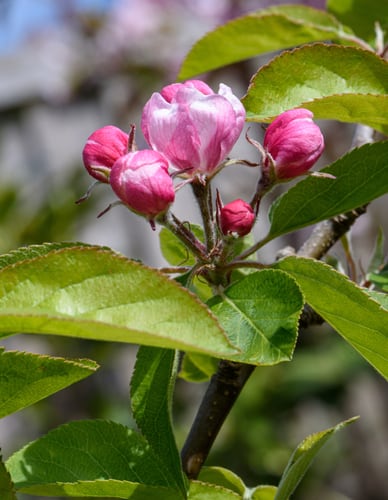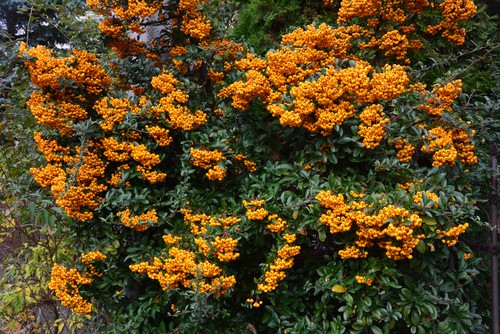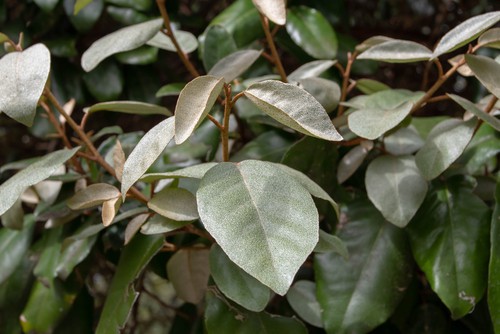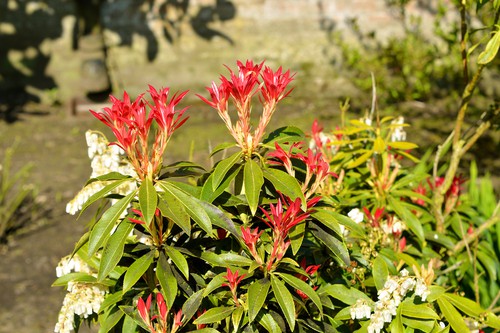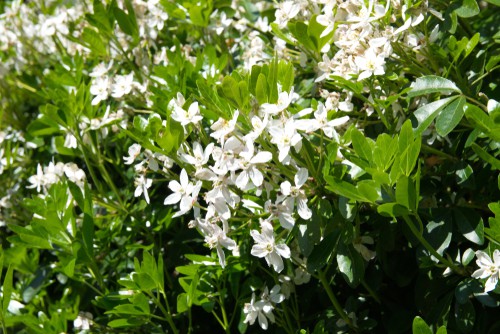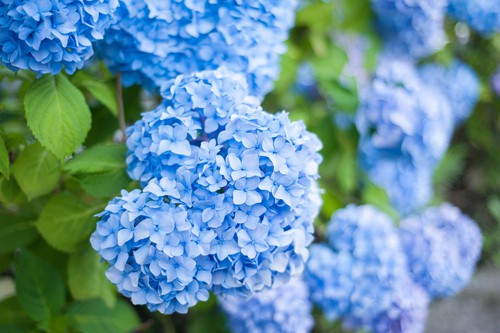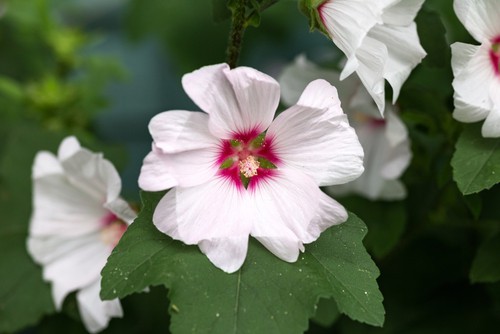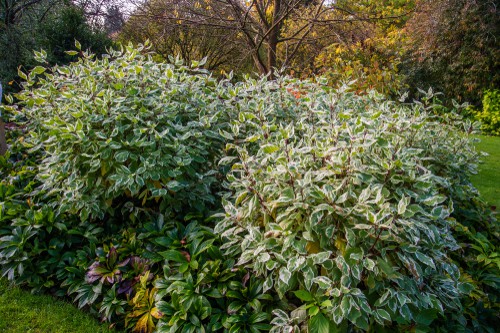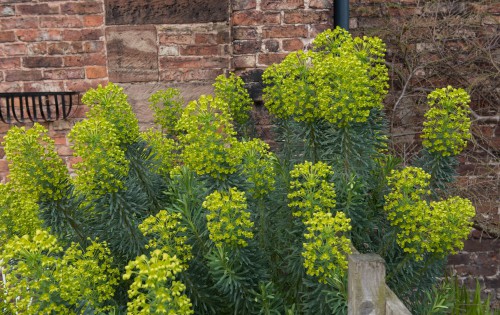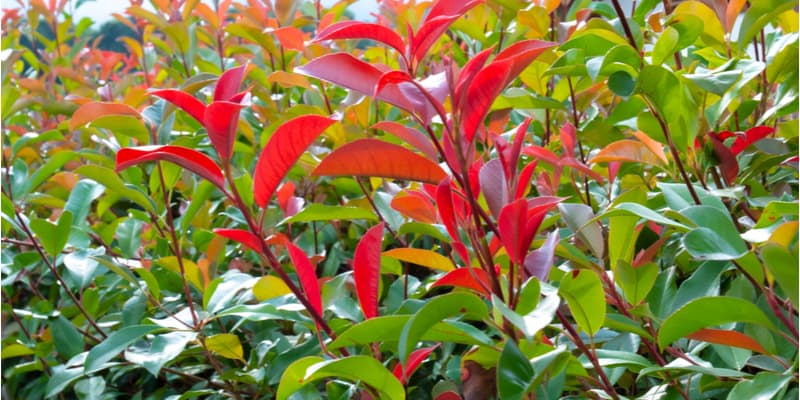
Fast Growing Shrubs For Filling In Spaces Quickly
Our site is reader supported, this means we may earn a small commission from Amazon and other affiliates when you buy through links on our site.
Many shrubs are resilient and add colour to the landscape regardless of the season. You can grow these plants in your garden to fill in bare spaces because they typically possess lush foliage. The fast-growing shrubs listed below offer different visual characteristics from coloured foliage to unforgettable blooms.
Please read further to discover what these fast growing shrubs have to offer.
1. Photinia ‘Red Robin’
The signature red foliage of photinia Red Robin has won over many, especially those looking for attractive hedge solutions. The evergreen plant displays red young leaves in spring and summer before converting to a permanent dark green colour. It also displays clusters of white blooms as spring ends, creating a lovely aesthetic.
Growing up to 13ft if left unpruned, this plant is perfect for filling spaces because it offers a compact spread. Additionally, it is easy to grow and does not have high water demands. The fully hardy plant thrives in neutral or acidic loam, sand, and clay soils with adequate drainage.
Receiving enough sunshine is also essential for the well-being of the plant. Place the plant where it can access partial or full sunshine for the best results. Do not forget to prune the plant in early spring or late winter before the new growth sets in and the risk of frost is not a danger.
Learn more about growing photinia red robin here
2. Escallonia ‘Apple Blossom’
Featuring pink and white blooms of a chalice design, the evergreen bush known as Apple Blossom, provides an ideal hedging solution. The plant possesses compact, abundant, dark green foliage that contrasts suitably with the blooms in summer.
It is a zone-4 hardy plant that thrives in numerous soil types with a neutral, alkaline, or acidic pH. Appreciating areas protected from the cold winds, this plant needs direct or partial sunlight.
The plant can be easily propagated through semi-hardwood cuttings harvested in late summer or softwood cuttings as summer begins. Pruning yearly is ideal for growth and shape control. It should be carried out after blooming ceases or in early spring for hedges that are not blooming.
No products found.
3. Pyracantha
Pyracantha is a charming evergreen plant that is known for its colourful orange/yellow/red berries and prickly stems. The prickly stems are linked to the rose family, but the flowers are not as intricate. Typically, the blooms appear in spring to the middle of summer, followed by the berries in autumn.
This evergreen has several species and various cultivars, which are hardy. When looking to cultivate a certain variety of pyracantha, find out about the specific characteristics to know whether it will survive the climate.
Growing them is not a hustle considering that they only need sunshine and well-drained fertile soils to survive. The water intake is not high, and it occasionally needs pruning to maintain the shape and remove dead plant material.
This plant and its cultivars are ideal for filling in spaces because of the dense foliage and ability to adapt to training against any surface, whether it is an arch or trellis. Ideally, the plant should receive trimming twice or three times annually between mid-spring and summer to retain the berries.
4. Elaeagnus ebbingei
Presenting lush foliage and small, delicate flowers, the Elaeagnus ebbingei is compact enough to fill gaps in your landscape. This plant is normally used for hedging purposes because it is low-maintenance but it can also be ornamental. The vigorous evergreen plant produces scented flowers in autumn, proceeding with the berries in winter.
It reaches a height of 4 metres and 2.5 m wide with broad, leathery foliage that creates a dense hedge whose neatness is maintained through trimming. The drought-tolerant thrives in various soils of neutral, acidic, or neutral pH, with few issues. Remember that the soil must be well-drained to prevent devastating diseases such as root rot.
The zone-5 plant thrives under full or partial sunlight, and you can use mulch to control moisture content in the soil, especially on hot days. A little pruning of unwanted shoots in the middle or end of spring will assist the plant to maintain healthy growth and a neat appearance. Deal with elaeagnus sucker and coral spot issues before they destroy the plant’s appearance.
5. Pieris japonica ‘Forest Flame’
One of the more beloved varieties of pieris includes the ‘Forest Flame’ that puts up a show in spring. This plant is known for its urn-shaped clusters of whitish blooms in spring paired together with the young colourful foliage that may be red, pink, or green. Usually, the younger leaves possess a colourful appearance before settling into a permanent green colour.
Tolerant of loam and sandy soils with good drainage, this evergreen shrub prefers an acidic pH. It also needs partially shaded areas or full access to the sun to flourish. The plant falls under group-8 pruning regulations, which means trimming after flowering ends.
During the blooming season, continue deadheading to assist the plant in producing more blooms. Furthermore, provide mulch and some fertiliser to help the plant recover faster.
Learn more about Pieris ‘Forest Flame’ in this guide here
6. Choiysa ternata
Choisya ternata is not a large plant, but it offers plenty of green foliage and a mass of white blooms. Also identified as Mexican orange blossom, this compact plant has an interesting flowering pattern. Blooms may appear intermittently in spring, summer or autumn and sometimes early winter. The flower displays and the accompanying scent is enough to attract different pollinators to the garden.
To make matters better, the plant grows in various soils, including chalk with proper drainage. It is hardy, therefore, making it easy to cultivate in soils of different pH. What you need to do is make sure the plant receives full sunlight and is protected from harsh chilly winds.
The drought-tolerant plant belonging to the fourth hardy zone is propagated through semi-hardwood cuttings harvested as summer ends. And while the evergreen plant grows to over 6ft, you can use pruning to regulate the height and shape. Please carry out pruning after blooming ends to encourage better growth in the coming season.
7. Hydrangea
Hydrangea is highly appreciated for its massive, conspicuous pink/purple/white/blue bloom clusters and lush compact foliage in summer. It has over 70 species spread out in the Americas and Asia, thus you can access varieties with different characteristics. Among the more popular varieties in the UK is the Hydrangea seemannii, Hydrangea anomala subsp. Petiolaris, and Hydrangea serratifolia.
Evergreen varieties of hydrangea are ideal for hedging, as they maintain their foliage year-round and can survive in cold conditions. If you want fully hardy hydrangea, try varieties such as Hydrangea anomala subsp. Petiolaris, which can withstand cold temperatures.
For hydrangea to flourish, you need to supply it with fertile, well-drained soils and access to the sun. Hydrangea can grow under full sunlight; however, the ideal setting would be under partial sunlight to prevent loss of moisture that results in wilting. You can help the plant retain its soil moisture content by mulching.
Pruning hydrangea is essential in maintaining the quality of blooms and maintaining overall shape. How you prune will depend on the variety of hydrangea you get because there are differences regarding when to prune.
Learn more about hydrangeas in my guide here
8. Lavatera ‘Barnsley’
This semi-evergreen perennial is another low maintenance plant that is bushy enough to fill any gaps you want. Manifesting sizable pinkish/white blooms in summer, this plant grows in most soils with varied pH. What is vital is that the soil is well-drained and nutritious for the plants to flourish.
The 2-metre tall plant also appreciates basking under the full sun, with mulch underneath to prevent loss of moisture. Apart from that, the zone-5 hardy plant requires pruning in the middle spring, permitting enough time for the new season’s growth to mature.
Deadheading is also a useful practice, as it allows the plant to save energy on incoming flowers rather than concentrating on spent blooms. Since lavatera attracts pollinators, deadheading will supply pollinators with fresh flowers to get nectar from.
Read my guide on how to grow lavatera in my detail here
9. Cornus alba
Cornus alba is a medium-sized deciduous suckering shrub with bright red stems in winter. The stems are not the only colourful feature in this plant because, in autumn, the ovate foliage morphs to a reddish colour with accompanying bluish/white berries. This plant also produces tiny white bloom clusters in spring and summer that complement the green foliage.
Perfect for your landscaping needs, this ornamental plant is easy to grow with the right conditions. Whether you choose clay, sandy, or loam soils, ensure that the pH ranges from acidic to neutral to prevent any problems. Aside from that, place the plants in a partially shaded area or directly under the sun.
The zone-7 hardy plant prefers to sit in well-drained soils, as waterlogged soils attract diseases such as cornus anthracnose. Cornus alba falls under the group 7 pruning category, which stipulates hard pruning should be done as winter ends or in early spring to create more colourful stems in the coming season.
10. Euphorbia characias subsp. Wulfenii (Mediterranean Spurge)
Armoured with stunning foliage and an impressive spread, this sub-shrub puts on quite a show. In spring and summer, the plant displays yellowish-greenish flowers that complement the plant’s greenish-grey foliage, creating a lovely aesthetic.
The medium-sized plant attains a height of about 1.5 metres with a 1.5-metre spread. It requires medium to dry soils such as sand, loam and chalk with good drainage for it to thrive without attracting unwanted fungal diseases. Being that it is a drought-tolerant plant, it does not need constant watering. If you provide the plant with mulch, it will be able to maintain the soil moisture level.
This plant is propagated through division or cuttings in spring and it should be severely pruned as summer ends or in early autumn to facilitate abundant growth the next season. Although the plant attracts pollinators, be careful of its poisonous sap to prevent skin irritations.
Final Thoughts
Evergreen plants are low maintenance; therefore, your work is simplified. Since you are spoiled for choice, you can pick different plants whose appearance complements each other. It is all up to the size of space you want to be filled and how far you can stretch your imagination. Did any of the evergreens presented above catch your attention? Please tell us in the comment section below.
Last update on 2025-07-05 / Affiliate links / Images from Amazon Product Advertising API
